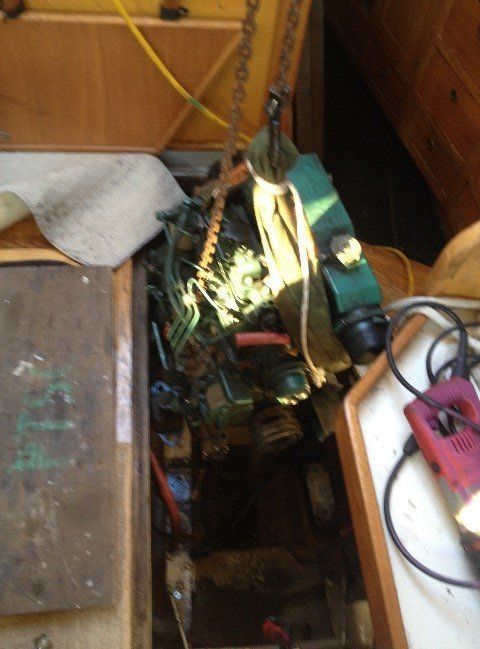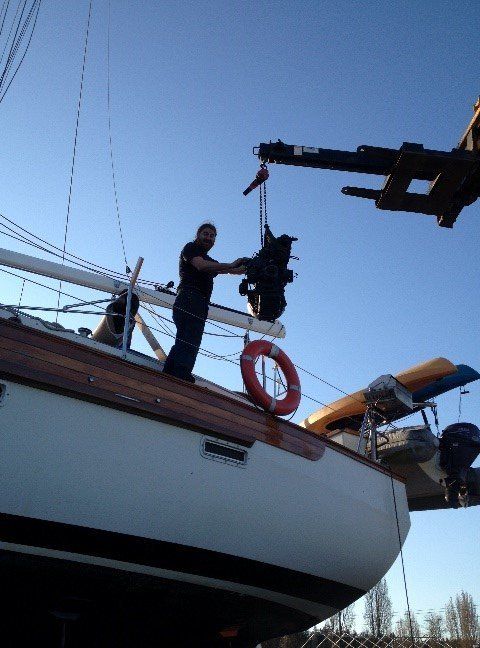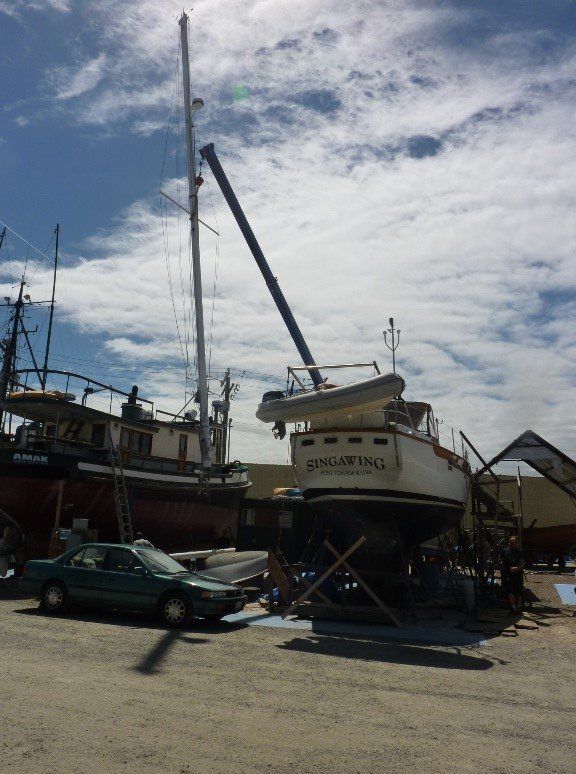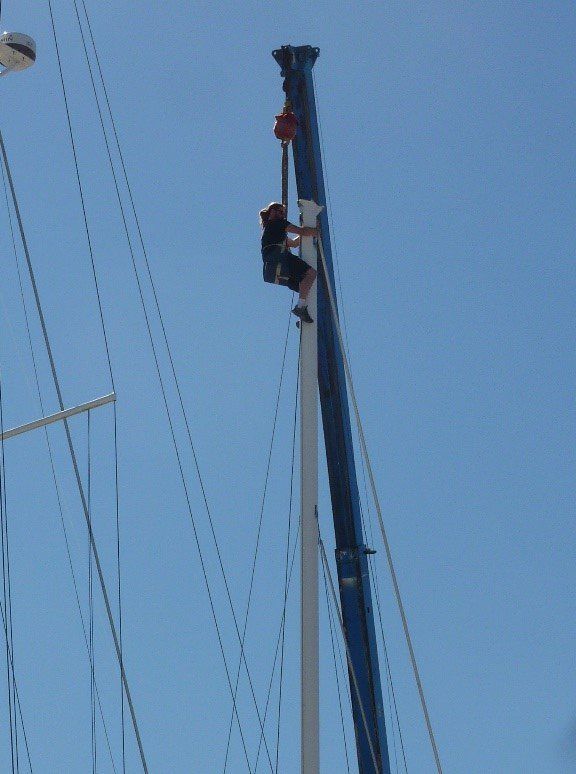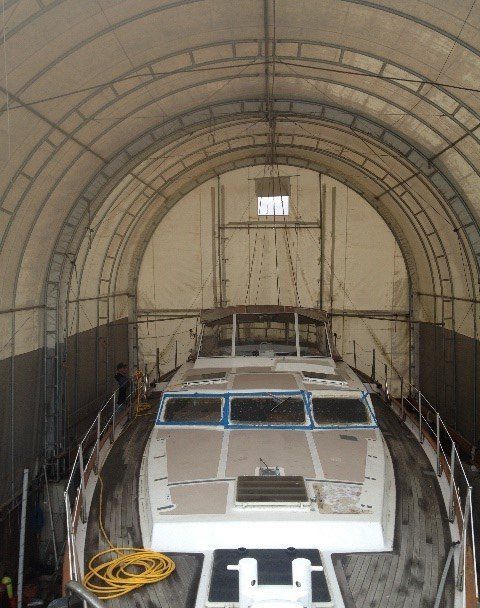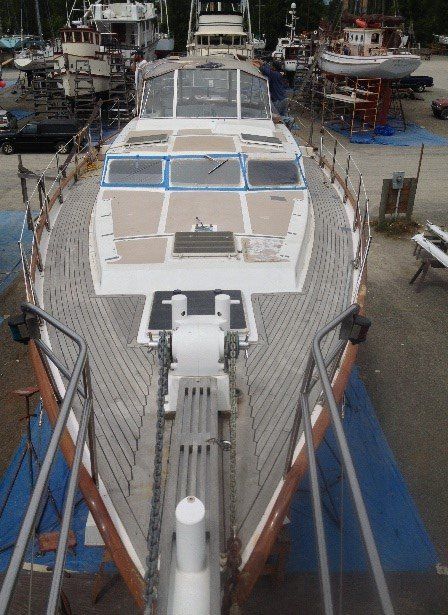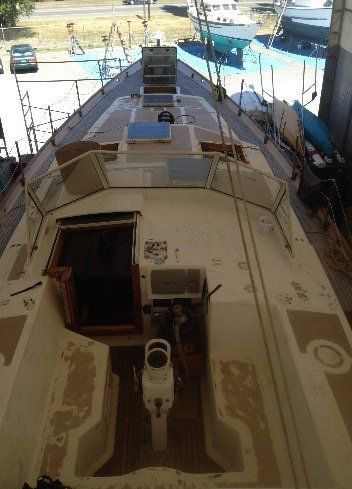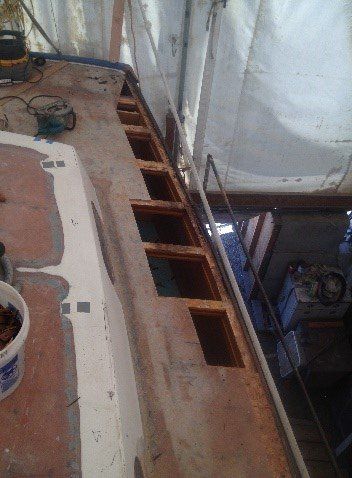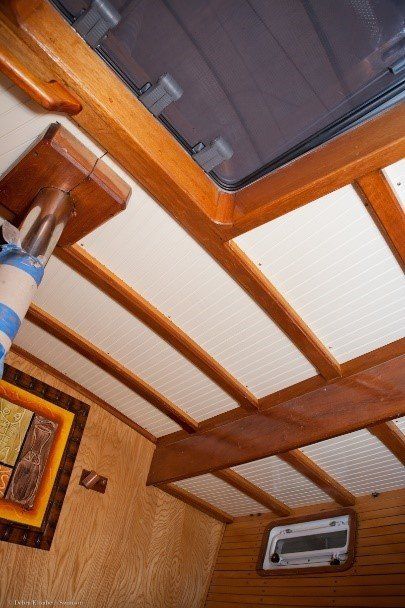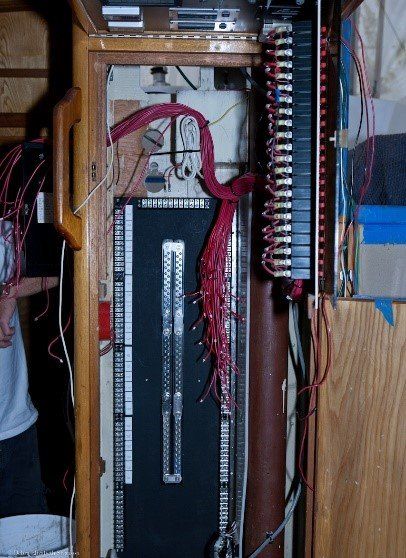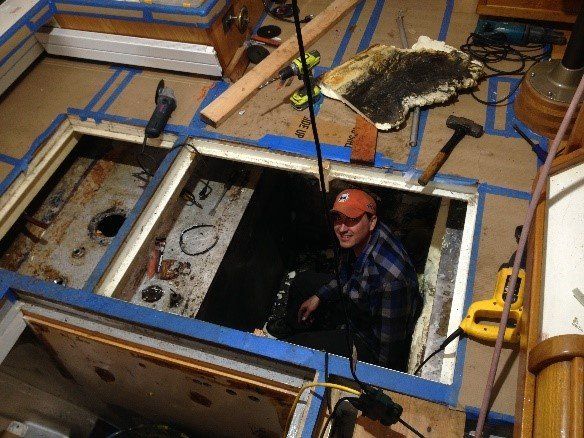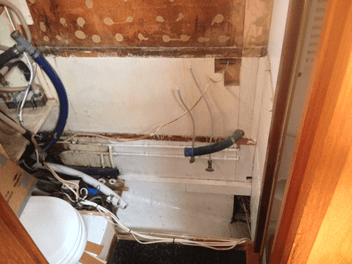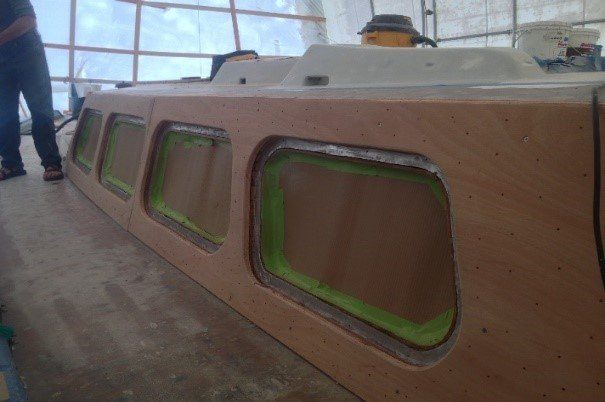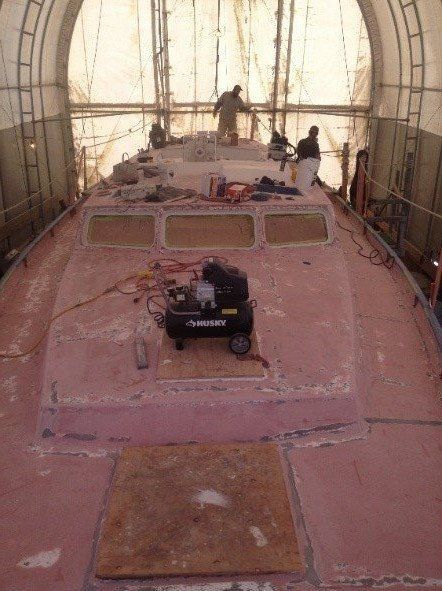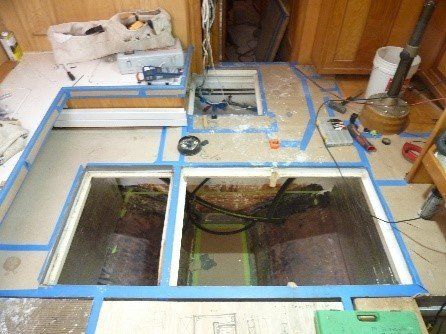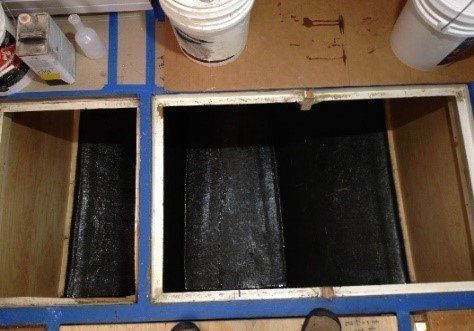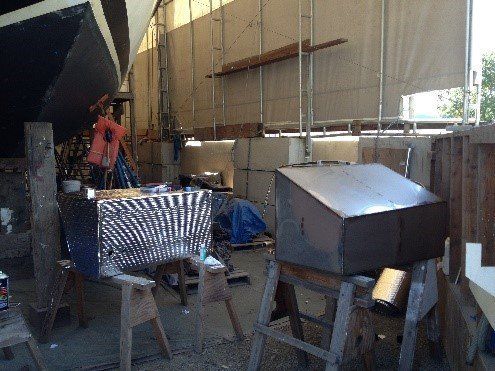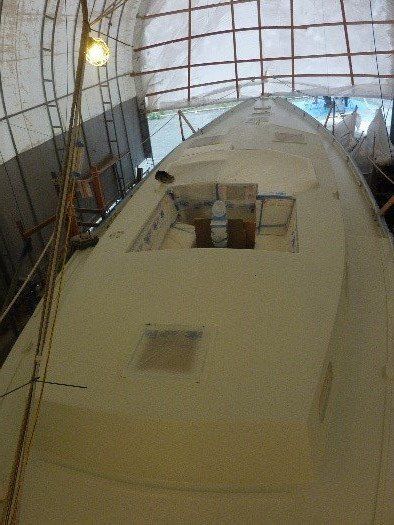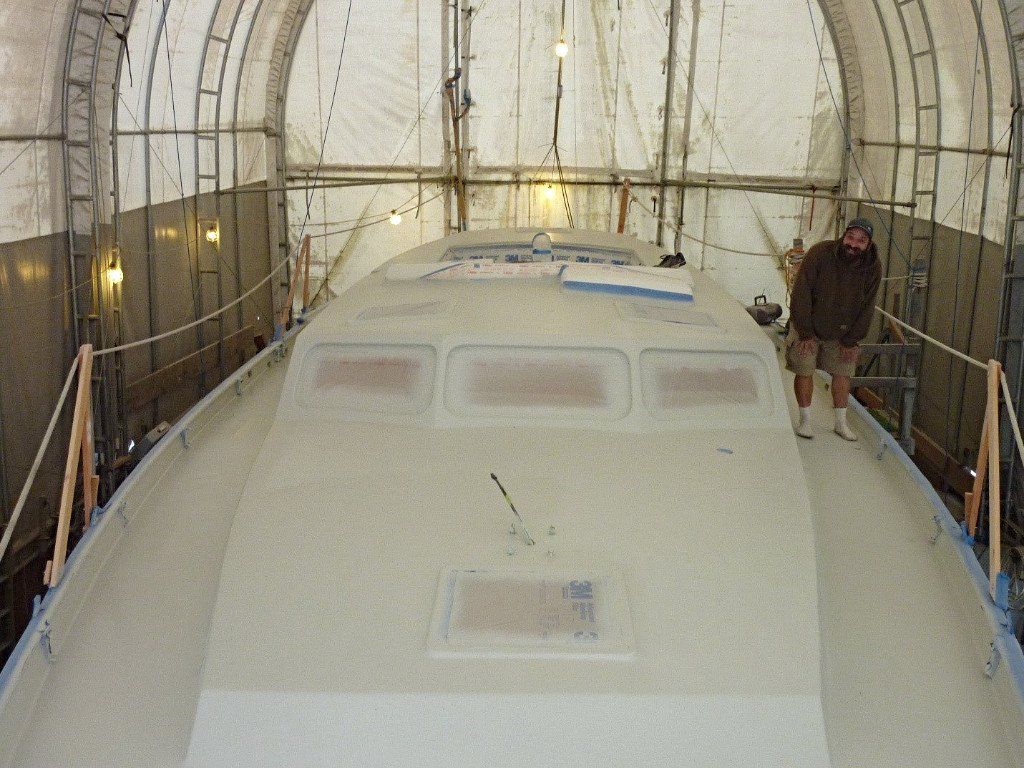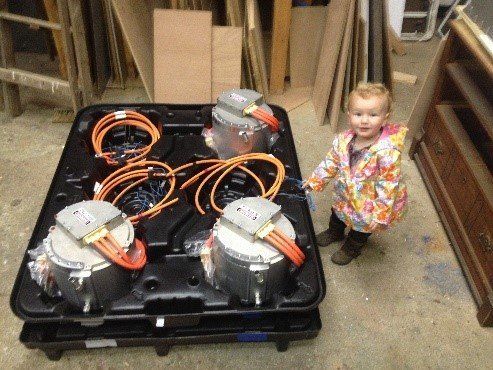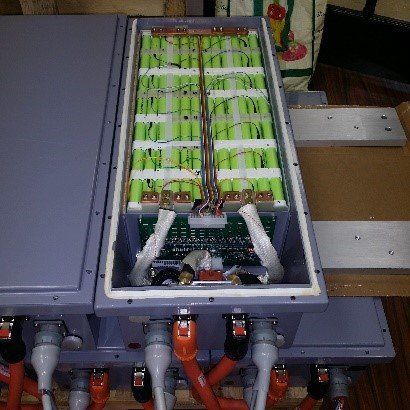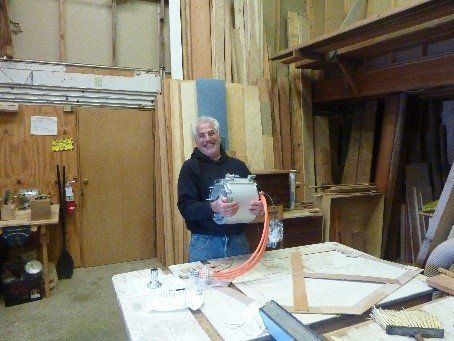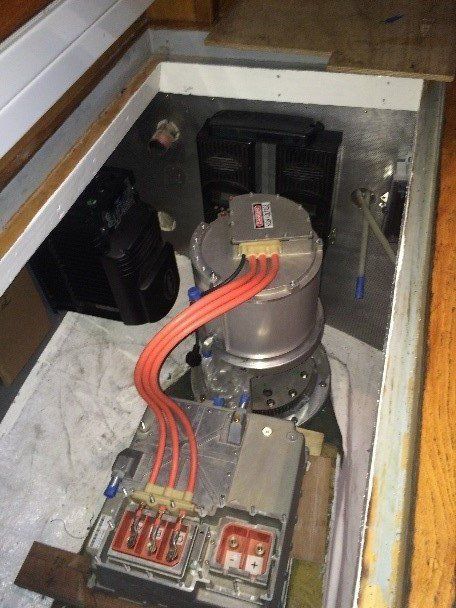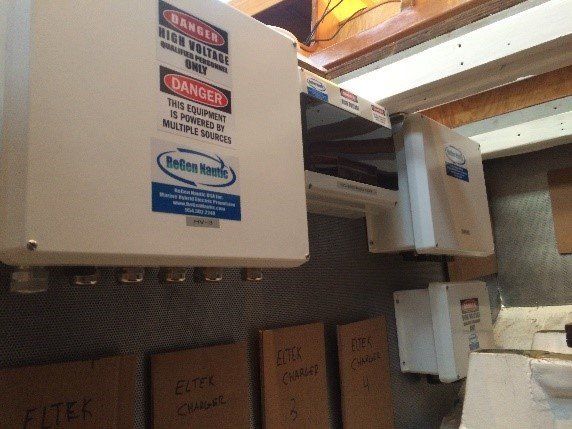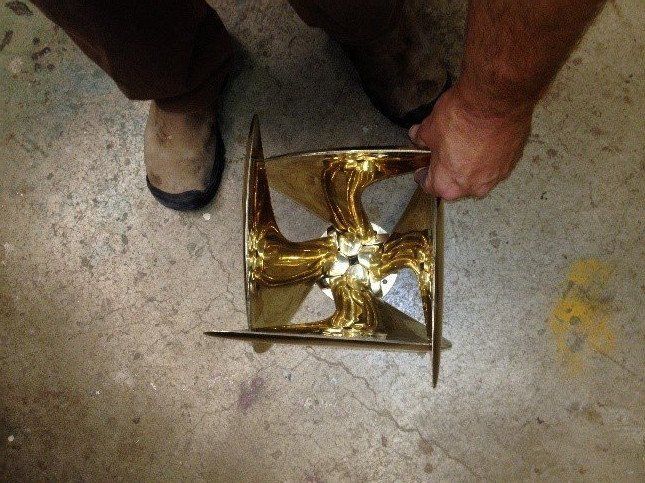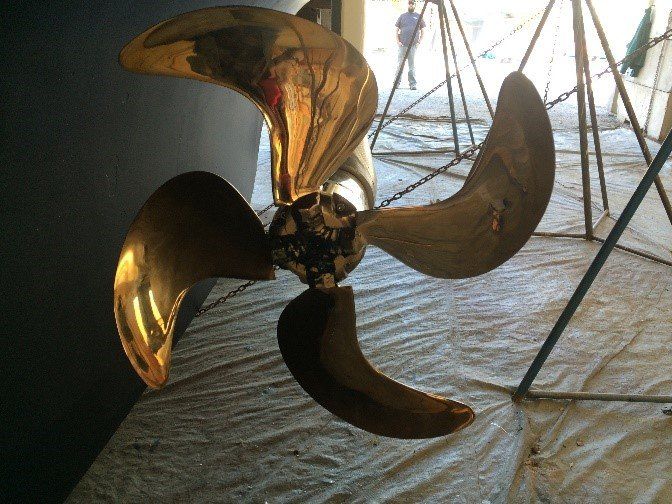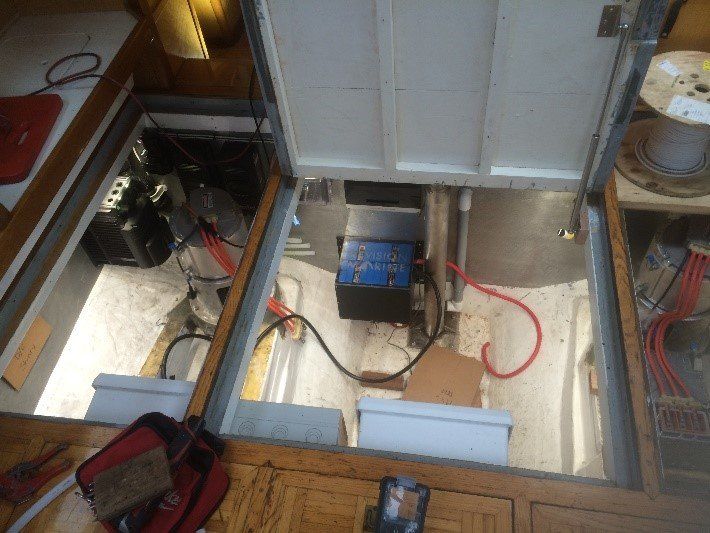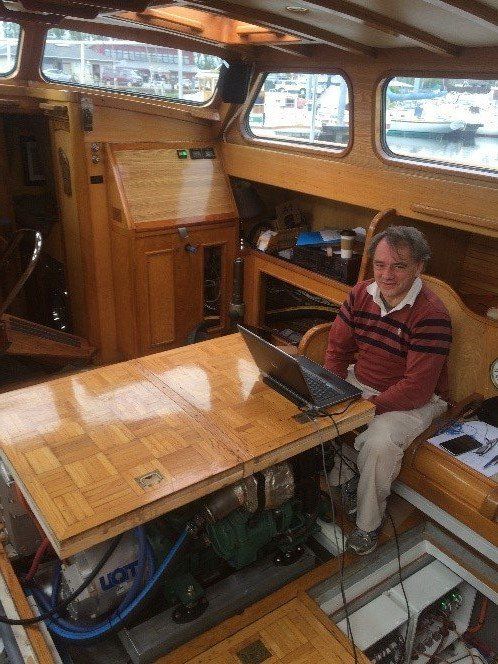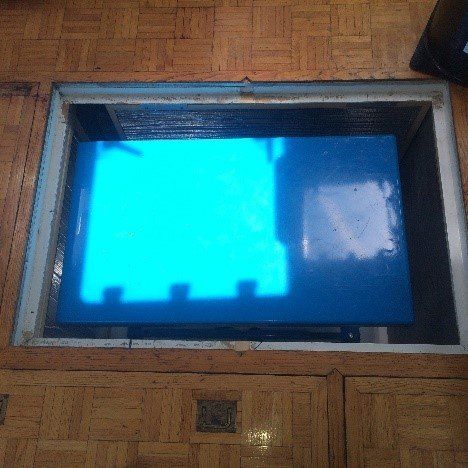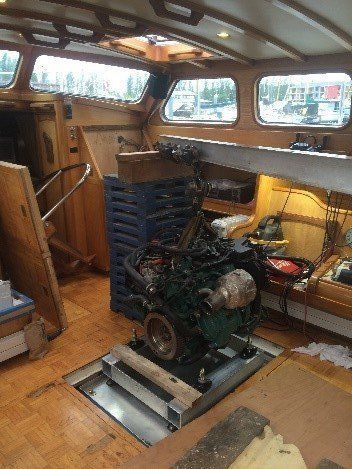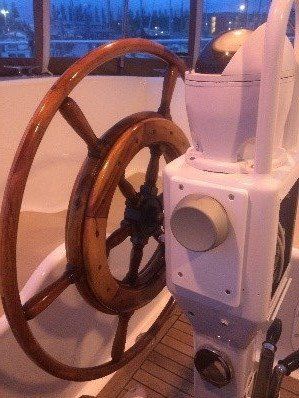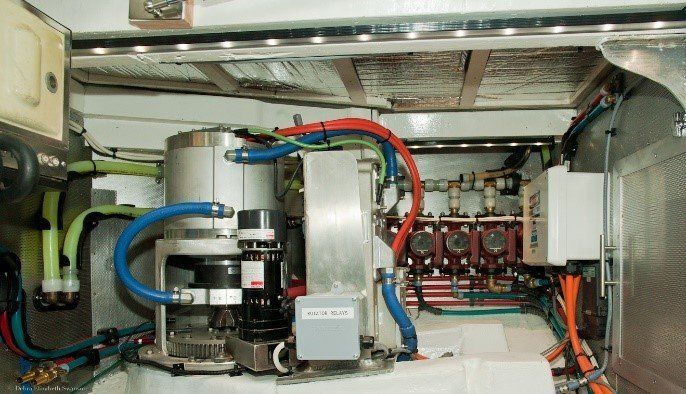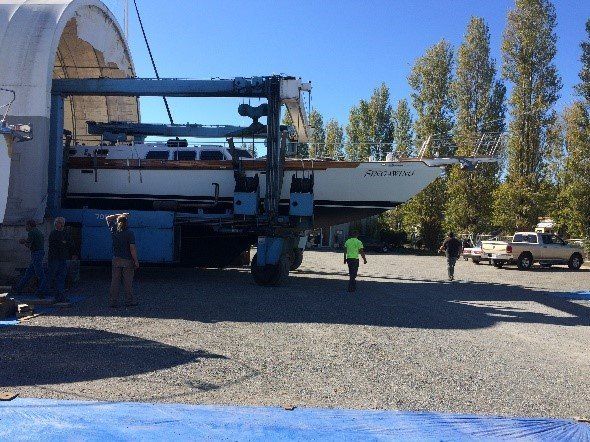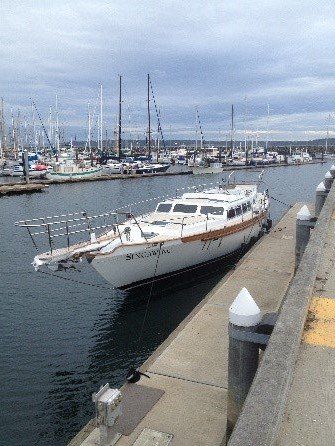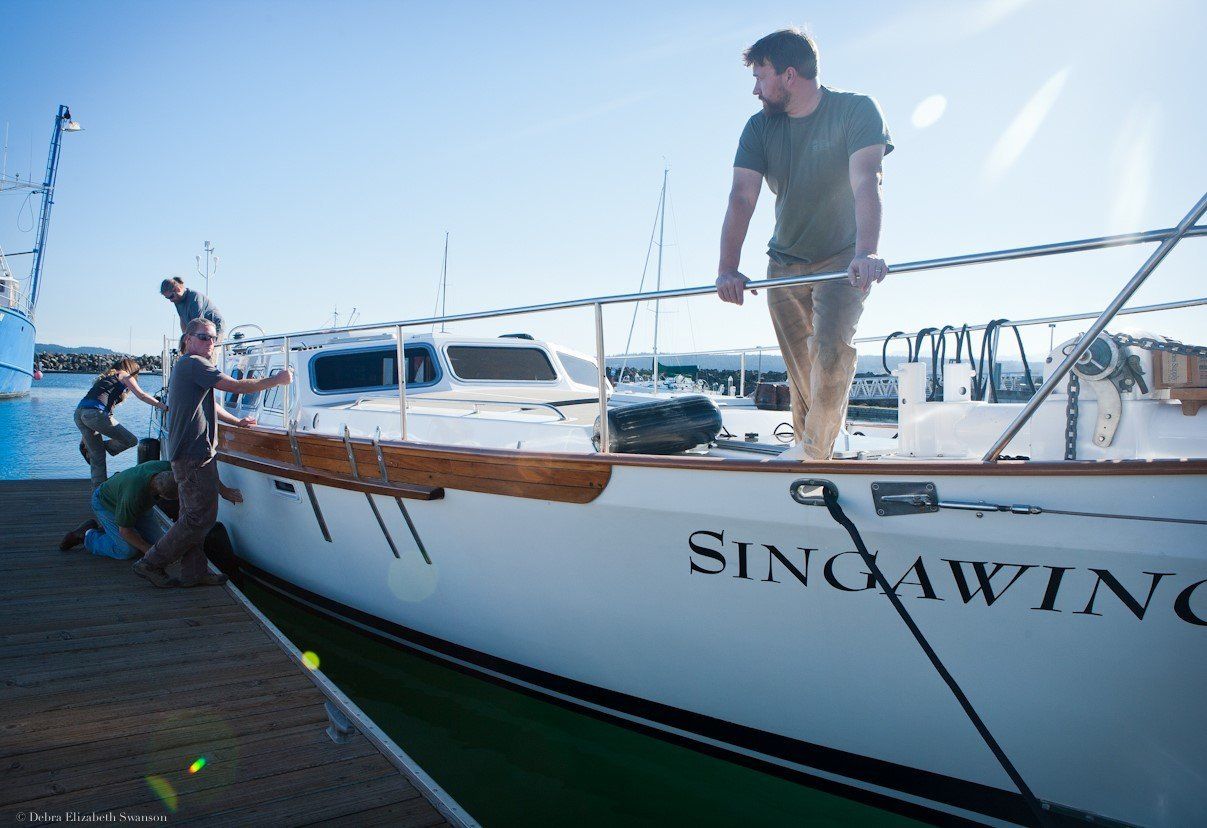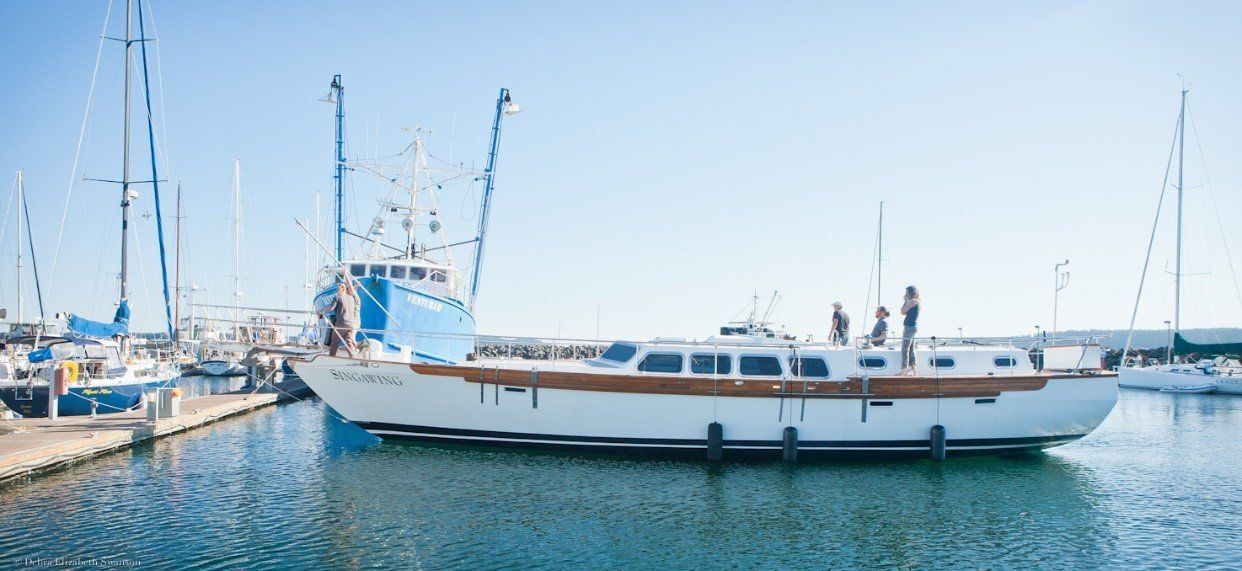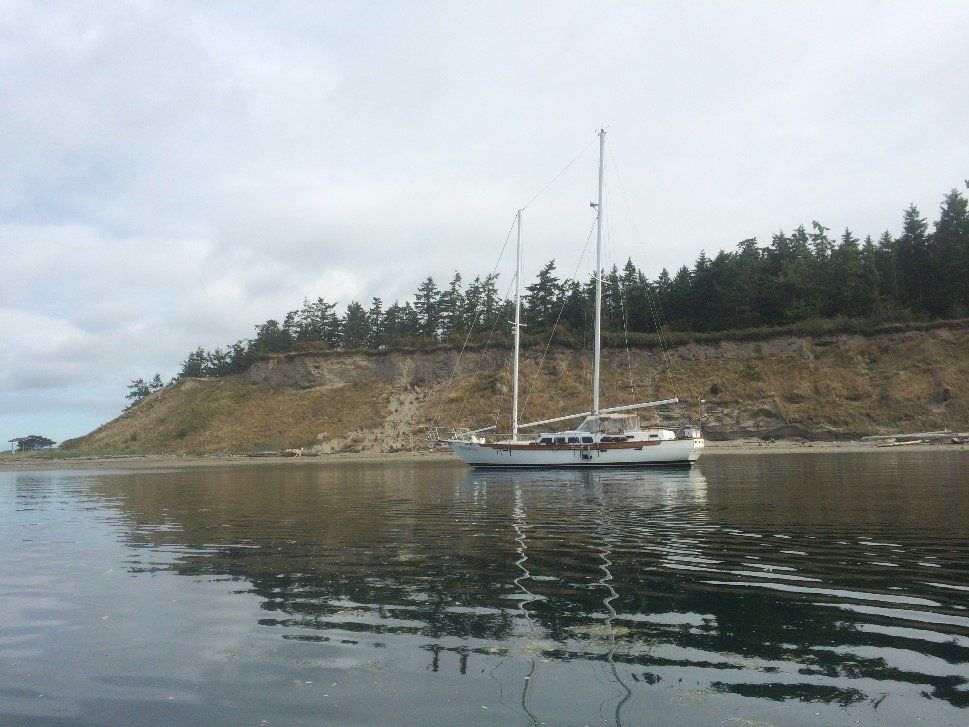3-Year Refit
Three-Year Refit
After the 2014 season Singawing was really beginning to show her age. Her paint job was failing miserably, her old engines were tired and constantly requiring maintenance, and her furling systems were no longer easy to operate. In the winter of 2014 it was decided that she really needed a refit and we felt up to the task. We began a three-year insanely complicated process that required thousands of man hours and much rehabilitation. Below are pictures representing a timeline of the job.
Meanwhile, Mark Miller was down below tearing out the old cabinets containing the black water tanks, and installing new tongue and groove overheads with aerogel insulation. Mark was also busy cutting and reshaping engine room hatches and installing red cedar in all of the cabinets and closets.
I was busy rewiring the entire boat.
I was busy rewiring the entire boat.
As the new decks went down, Rob Nadge and Roy Secondez began the intense fairing and prepping work for a new Awlgrip paint job. Todd Flye was able to stay just ahead of the paint crew as he laid sheet after sheet of fiberglass. The cabin sides were increased by 2 inches to allow for new double pain gas charged windows with 3/8 tempered, tinted glass on the outside and ¼ inch safety laminated glass on the interior (no more sweating windows). An additional benefit to expanding the cabin width was that it made room to run the forward stay sail rigging hidden inside the cabin sides. This chamber would accommodate the furling lines for the new Pro Furl system purchased and installed by Dan and Lisa and the crew at PT Rigging.
Back down below, Todd was busy building an integral fiberglass 180-gallon diesel tank in the bilge where the former diesel tanks resided. New stainless steel water tanks built by Peters Marine were fitted and installed outboard in their previous locations. Mark Miller then built sound insulated bulkheads to retain the water tanks and separate them from the new engine room space.
During this operation, the entire original engine room was stripped of its contents, repainted and prepped for the new propulsion system. The guys at Port Townsend Shipwrights Coop were busy replacing both the fore and aft compression posts with single stainless steel 80 gauge pipes. Dan Radden had completed two new fiberglass holding tanks and they were installed and hard piped to avoid smells.

By this time the fairing was complete and paint was being laid down. Rob did an excellent job, well beyond my expectations. We decided to forego new teak decking and went with a tan nonskid that really has a clean look. We then had to begin the arduous task of reinstalling all the hardware. New hatches were purchased and installed and the big companion way and sail hatches along with the cockpit windshield were powder coated to a pewter color.
Just after the primary winches were installed, we took a much-needed trip to Hawaii. It was at the airport on my way home that I learned that my dear friend and painter, Rob Nadge, had suffered a coronary embolism and died instantly. Singawing would be his swan song and he is greatly missed.
In Rob’s absence I was struggling to find and install all of the hardware and luckily my friend Elton Schweitzer was looking for work, and so he became instrumental in finding, polishing, bedding, and installing everything we had removed a year-and-a-half before. Elton then lent his hand with all the exterior varnishing and even buffed the old hull back to a mirror finish.
With most of the exterior work completed, we began to install the new serial hybrid electric propulsion system. The battery room was gutted and rebuilt to accommodate a 50 KWH lithium NMC battery bank with the ability to contain a 150 KWH bank when it becomes more affordable.
With most of the exterior work completed, we began to install the new serial hybrid electric propulsion system. The battery room was gutted and rebuilt to accommodate a 50 KWH lithium NMC battery bank with the ability to contain a 150 KWH bank when it becomes more affordable.
Regen Nautics INC from Dania beach Florida was selected to supply the components and software for the job. I designed a custom 360 degree rotating saildrive that the 135 HP permanent magnet, three phase, variable frequency drive, electric motors would sit vertically atop. After Tim Nolan sent Jonathan Moore over to do the engineering work, Aaron Day from PT Shipwrights Coop custom machined all of the necessary parts and installed them into the faired hull that Tod Flye the “perfectionist” worked so hard at.
With my Revision Marine partners, Chris Brignoli and Peter Geerlofs, we designed, built and installed a custom 300-amp hour lithium iron phosphate battery bank for the ship’s house or hotel loads. Jean-Marc Zanni arrived from Florida, programed the entire propulsion system and helped to install the remaining propulsion equipment including the 150HP Volvo Penta D3 100 KWH D/C generator.
Early on It was decided that the generator would be inaccessible for maintenance in the location above the new fuel tank amidships, so we installed a scissor lift table to bring the big power plant up into the saloon. Because of the lack of a shaft this was done relatively easily and we are delighted with the result.
After all of the plumbing and wiring, Singawing is up and running beautifully. We hit our target consumption levels on the mark. At 6.2 Knots, she consumes 16 KW per hour giving her a 3-hour range before the generator auto starts. At 7 knots, she consumes approximately 20 KW allowing for 2 hours of silent travel. From the deck, it sounds just like sailing. When the generator starts, it runs for about an hour-and-a-half and then shuts down for 2.5 more hours. The batteries can be charged in 6 hours using a 50 amp 240-volt shore power cord. We have not been able to fully test the regen functions but from the test we have performed we believe she will produce 4-5 KW an hour at 8 knots of sailing speed.
Four 190 watt solar panels were installed above the dinghy davits and provide all of the necessary power required to operate the vessel’s systems. In the event of continuous cloud cover, the house battery can be charged from the high voltage propulsion bank giving Singawing a ten-day autonomy of household power needs. At that point the engine can be started and the big battery recharged in a little over an hour.
We are installing a 30,000 BTU reverse cycle heat pump air conditioning unit to replace the old hurricane heater. This new system will allow the boat to heat or cool off of the propulsion bank for up to 2 days without starting the engine and is considerably more efficient that the diesel system it replaces.
We are installing a 30,000 BTU reverse cycle heat pump air conditioning unit to replace the old hurricane heater. This new system will allow the boat to heat or cool off of the propulsion bank for up to 2 days without starting the engine and is considerably more efficient that the diesel system it replaces.
Thanks for taking the time to read about this experience. Please come see the boat with you own eyes. We are happy to give full tours.
Green For Real, Not For Feel
Over 95% of our local day sails are completed without burning one drop of fossil fuel!
Over 95% of our local day sails are completed without burning one drop of fossil fuel!
